Yawning
By Robert R. Provine
The yawn is primal, unstoppable and contagious, revealing the evolutionary and neural basis of empathy and unconscious behavior
The yawn is primal, unstoppable and contagious, revealing the evolutionary and neural basis of empathy and unconscious behavior

DOI: 10.1511/2005.56.532
Imagine a yawn. You stretch your jaws open in a wide gape, take a deep inward breath, followed by a shorter exhalation, and end by closing your jaws. Ahhh. You have just joined vertebrates everywhere in one of the animal kingdom's most ancient rites.
Mammals and most other animals with backbones yawn; fish, turtles, crocodiles and birds do it. People start yawning very early, offering further evidence of its ancient origins. Yawning is present by the end of the first trimester of prenatal human development and is obvious in newborns.

Elizabeth Dalziel/The Associated Press
Yawning is a wonderfully rich topic for anyone interested in the neural mechanisms of behavior. The simple, stereotyped nature of the yawn permits rigorous description, a first step in discovering neural mechanisms. And this application of the "simple systems" approach involves human beings going about their normal activities; there's no need to use bacteria, fruit flies or nematodes. You can forget about cleaning messy animal cages—much can be learned by experimenting on oneself and observing fellow Homo sapiens.
By now, you may be experiencing one of the most remarkable properties of yawning: its contagion. Yawns are so infectious that simply reading or thinking about them can be the vector of an infectious response. The property of contagiousness offers an opportunity to explore the neurological roots of social behavior, face detection, empathy, imitation, and the possible pathology of these processes in autism, schizophrenia and brain damage.
Fortunately for aspiring students of yawning, the scientific frontiers are near and relatively unpopulated, the result of our tendency to undervalue and neglect the commonplace. Serious science may require no more than a stopwatch, note pad and pencil. The accessibility of yawning as a problem makes it ideal for what I call "sidewalk neuroscience," a low-tech approach to the brain and behavior based on everyday experience. Whether you follow in my scientific footsteps or simply read along, don't be put off by the primitive tools, simple methods and behavioral focus. It's easy to be seduced by the trappings of big science and to neglect the extraordinary in our midst.
When I began to study yawning in the 1980s, it was difficult to convince some of my research students of the merits of "yawning science." Although it may appear quirky, my decision to study yawning was a logical extension to human beings of my research in developmental neuroscience, reported in such papers as "Wing-flapping during Development and Evolution." As a neurobehavioral problem, there is not much difference between the wing-flapping of birds and the face- and body-flapping of human yawners.
The verb "to yawn" is derived from the Old English ganien or ginian, meaning to gape or open wide (chasms really do yawn). But in addition to gaping jaws, yawning has significant features that are easy to observe and analyze. I collected yawns to study by tapping the contagion response. Back in the 1980s I asked subjects sitting in an isolation chamber to "think about yawning," and to push a button at the start of a yawn and keep it depressed until they finished exhaling at the end of a yawn. (Self-report was used because yawning is inhibited in subjects who think they are being observed.)
Here are some of the things I learned: The yawn is highly stereotyped but not invariant in duration and form. It is an excellent example of the instinctive "fixed action pattern" of classical animal-behavior study, or ethology. It is not a reflex, a short-duration, rapid, proportional response to a simple stimulus. But once started, a yawn progresses with the inevitability of a sneeze. The yawn runs its course over about six seconds on average, but its duration can range from about three and a half seconds to much longer than the average. There are no half-yawns, an example of the "typical intensity" of fixed action patterns and a reason why you cannot stifle a yawn. Yawns come in bouts, with a highly variable inter-yawn interval of around 68 seconds. There is no relation between yawn frequency and duration; producers of short or long yawns do not compensate by yawning more or less often.
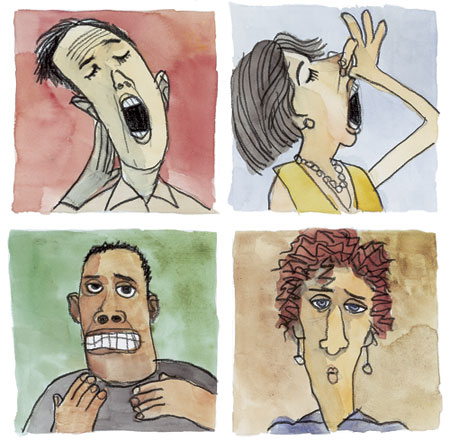
Tom Dunne
I offer three informative yawn variants that test hypotheses about the form and function of yawning. If you are now yawning, you can test yourself and draw your own conclusions about yawning and its underlying mechanism. Not everyone, including my long-suffering wife, shares my enthusiasm for such self-experimentation. And even enthusiasts may want to conduct these experiments in private. Let's begin.
The closed-nose yawn. When you feel yourself start to yawn, pinch your nose closed. Most subjects report being able to perform perfectly normal closed-nose yawns. This indicates that the inhalation at the onset of a yawn, and the exhalation at its terminus, need not involve the nostrils—the mouth provides a sufficient airway.
Now let's test some propositions about the role of the mouth and jaw.
The clenched-teeth yawn. When you feel yourself begin to yawn, clench your teeth, but permit yourself to inhale normally through your open lips and clenched teeth. This diabolical variant gives one the sensation of being stuck in mid-yawn. It shows that the gaping of the jaws is an essential component of the complex motor program of the yawn; unless it is accomplished, the program will not run to completion. The yawn is also shown to be more than a deep breath, because, unlike normal breathing, inhalation and exhalation cannot be performed as well through the clenched teeth as through the nose.
The nose yawn. This variant tests the adequacy of the nasal airway to sustain a yawn. (The closed-nose yawn already showed the nasal airway to be unnecessary for yawns.) Unlike normal breathing, which can be performed equally well through mouth or nose, yawning is impossible via nasal inhalation alone. As with the clenched-teeth yawn, the nose-yawn provides the unfulfilling sensation of being stuck in mid-yawn. Inhalation through the mouth is an essential component of the motor pattern of yawning. Exhalation, on the other hand, can be accomplished equally well through nose or mouth.
So far, you and I have demonstrated that inhalation through the oral airway and the gaping of the jaws are essential for normal yawns, and that the motor program for yawning will not run to completion without feedback that these parts of the program have been accomplished. But yawning is a powerful, generalized movement that involves much more than airway maneuvers and jaw-gaping. When yawning, you also stretch your facial muscles, tilt your head back, narrow or close your eyes, tear, salivate, open the eustachian tubes of your middle ear and perform many other, yet unspecified, cardiovascular, neuromuscular and respiratory acts. Perhaps yawning shares components with other behavior, all being assembled from a neurological parts bin of ancient motor programs. For example, is the yawn a kind of "slow sneeze," or is the sneeze a "fast yawn?" Both share common respiratory and motor features, including jaw gaping, eye closing and head tilting.
Looking at other kinds of behavior that use some of the same components, we might ask: Does the yawnlike facial expression during sexual climax suggest that the two acts share a neurobehavioral heritage? This proposition is not as far-fetched as it sounds on first hearing, because yawning is triggered by androgens and oxytocin and is associated with other sex-related agents and acts. Doctoral student Wolter Seuntjens at the Vrije Universiteit Amsterdam tracked down these connections when he surveyed the surprisingly extensive but scattered literature on this subject for his dissertation in art history, published last year. Among most mammals, males are the leading yawners. Our species is unique in that both sexes yawn equally often and are sexually receptive at all times. In rats, most chemical agents that produce yawning and stretching also produce penile erection. Although such antidepressant drugs as clomipramine (Anafranil) and fluoxetine (Prozac) typically depress sexual desire and performance, in a few people they have the interesting side effect of producing yawns that trigger orgasms.
Most human yawners are not rewarded with orgasms. But yawning does feel good to most people, being rated 8.5 on a 10-point hedonic scale (1=bad, 10=good). Given the similarities between sexual orgasm, yawning and sneezing (including some resemblances among the typical facial expressions), it's perfectly reasonable to refer to the resolution of all three acts as a "climax." Is the frustration of being unable to resolve building sexual tension in climax akin to the unsatisfying sensation of being stuck in mid-yawn or mid-sneeze? The chronic urge but inability to yawn is quite disturbing to those who experience it; several people with this problem have contacted me about gaining relief. Given these insights, you can now view your yawning and sneezing friends in a completely different light.
Yawning and stretching also share properties and may be performed together as parts of a global motor complex. But they do not always co-occur—people usually yawn when we stretch, but we don't always stretch when we yawn, especially before bedtime. Studies by J. I. P deVries, G. H. A. Visser and H. F. Prechtl in the early 1980s, charting movement in the developing fetus using ultrasound, observed not just yawning but a link between yawning and stretching as early as the end of the first prenatal trimester.
The most extraordinary demonstration of the yawn-stretch linkage occurs in many people paralyzed on one side of their body because of brain damage caused by a stroke. The prominent British neurologist Sir Francis Walshe noted in 1923 that when these hemiplegics yawn, they are startled and mystified to observe that their otherwise paralyzed arm rises and flexes automatically in what neurologists term an "associated response." Yawning apparently activates undamaged, unconsciously controlled connections between the brain and the cord motor system innervating the paralyzed limb. It is not known whether the associated response is a positive prognosis for recovery, nor whether yawning is therapeutic for reinnervation or prevention of muscular atrophy.
Clinical neurology offers other surprises. Some patients with "locked-in" syndrome, who are almost totally deprived of the ability to move voluntarily, can yawn normally. The neural circuits for spontaneous yawning must exist in the brain stem near other respiratory and vasomotor centers, because yawning is performed by anencephalics who possess only the medulla oblongata. The multiplicity of stimuli of contagious yawning, by contrast, implicates many higher brain regions.
Having considered the motor act of yawning, I'm ready to test some of the folklore about when and why we yawn. Although often in error, folklore poses interesting questions and is the repository of centuries of informal observations about human nature. A disadvantage of testing folklore is that when it's confirmed, you're accused of proving the obvious. Research has sometimes confirmed and extended common beliefs about yawning, but my colleagues and I have been rewarded with plenty of surprises.

Tom Dunne
We yawn when bored. Score a point for folklore. Bored people really do yawn a lot. To induce ennui, I asked subjects to watch a television test pattern for 30 minutes while giving those in the control condition a 30-minute dose of music videos. However you feel about music videos, you will find them more interesting (less boring) than an unchanging color-bar test pattern. Subjects yawned about 70 percent more during the test pattern than during the music video condition. But yawning is not exclusive to the bored; there is anecdotal evidence of yawning by paratroopers before their first parachute jump, Olympic athletes before their event, a violinist waiting to go on stage to perform a concerto, and dogs on the threshold of attack.
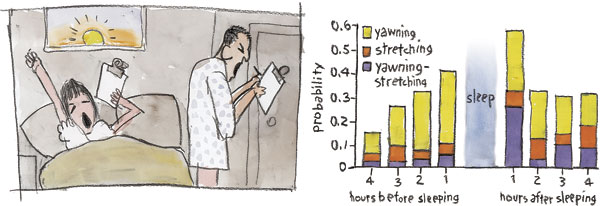
Tom Dunne
We yawn when sleepy. As expected, subjects who recorded their yawning and sleeping in a diary during a one-week period confirmed that people really do yawn most when sleepy, especially during the hour after waking, and second most during the pre-bedtime hour. A surprise came from accompanying data about stretching that subjects also recorded in their diaries. After waking, subjects simultaneously yawned and stretched. But before bedtime, most subjects only yawned. You can observe this yawn-stretch linkage in your family dog or cat as it rouses from its slumber.
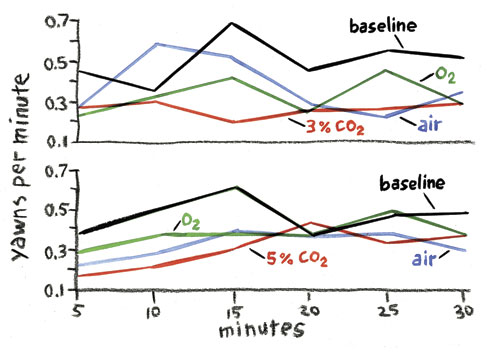
Tom Dunne
We yawn because of a high level of carbon dioxide or a shortage of oxygen in the blood or brain. These legendary but unsupported factoids are repeated so often that they have a life of their own, still being presented in the popular media and in medical-school lectures. Yet the only test of these hypotheses, one that I conducted 18 years ago, rejected them. Breathing levels of carbon dioxide a hundred or more times greater than the concentration in air (3 percent or 5 percent CO2 versus the usual 0.03 percent CO2) did not increase yawning, although subjects did dramatically increase their breathing rate and tidal volume. Furthermore, breathing 100-percent oxygen did not inhibit yawning.
Although breathing and yawning both involve respiratory acts and are produced by neurological motor programs, these programs are separate and can be modulated independently. An exercise task, for example, that had subjects huffing and puffing at high rates did not affect their rate of ongoing yawning. Test this proposition during your next jog (but not sprint). Thoughts about yawning will prompt yawns that can be sustained independent of how labored your breathing becomes.
The legendary infectiousness of yawning can be confirmed with simple observation, but the full story about contagion is so broad and deep that it deserves extended treatment. Before exploring its exciting implications for social biology, I will quantify the contagiousness of yawning and define its stimulus triggers.
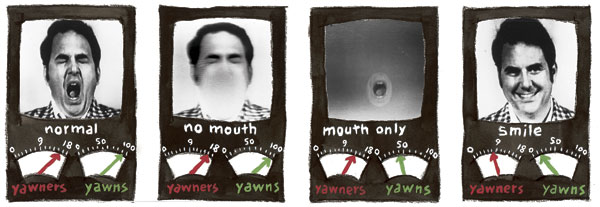
Video images courtesy of the author. Illustration by Tom Dunne.
In early experiments, I tested the contagiousness of yawning by exposing subjects to a five-minute series of 30 videotaped repetitions of a male adult yawning. Subjects were more than twice as likely to yawn while observing yawns (55 percent) as to yawn while viewing a comparable series of smiles (21 percent). Unlike the response of a reflex to a stimulus, the visual stimulus was not followed by a short and predictable latency period; instead, yawning took place throughout the 5-minute test period. In the language of classical ethology, the yawning face is a sign stimulus, which activates an innate mechanism that releases the fixed action pattern of the yawn.
The yawn video proved equally potent whether viewed right side up, sideways or upside down. Furthermore, the subjects' yawn detector was neither color nor movement dependent, because the video was equally potent when viewed in black and white or in color, or when the usually animate stimulus was presented as a still image of the yawner in mid-yawn.
Next I tested what features of the yawning face were most potent in prompting yawns. I even hoped to be able to engineer a supranormal stimulus—the mother of all yawn stimuli. Here the plot thickened. Most people incorrectly presume that the gaping mouth is the essential signature of the yawn. Yet it turned out that yawning faces that had been edited to mask the mouth were just as effective in producing yawns as the intact face. I was skeptical of this finding until complementary data showed that the disembodied yawning mouth was no more effective in evoking yawns than the control smile.
Outside the context of the yawning face, it seems that the gaping mouth is an ambiguous stimulus—the mouth could equally well be yelling or singing. The detector seems to be responding to the overall pattern of the yawning face and upper body, not a particular facial feature. Miss Manners, take note: This incidental contribution to etiquette research suggests that shielding your mouth is a polite but futile gesture that will not prevent the passing of your yawn to others.
Nature conspires to spread yawns. Even thinking about yawning, the yawn-induction procedure used in several of my studies, evoked yawns in 88 percent of subjects within 30 minutes. And as many readers have noticed by now, reading about yawning triggers yawns. When put to the test, 30 percent of subjects who read an article about yawning for 5 minutes reported yawning during this period, versus 11 percent of a control group who read an article about hiccuping. When the criterion was relaxed to include those who either yawned or were tempted to yawn, the difference between the yawn and hiccup conditions grew to 75 percent and 11 percent, respectively.
My plan to develop an ultra-potent yawn stimulus was abandoned when I discovered the global nature of yawn triggers. I realized that synthesizing a gaping mouth of just the right size that opened and closed at just the right rate would not produce the perfect, irresistible stimulus. The observation of a naturally yawning person does just fine by itself. Also, otherwise neutral stimuli can acquire yawn-inducing properties through association. My reputation as a yawn sleuth has conferred a curious kind of charisma—I've become a yawn stimulus.
Yawns are replicated by observers who pass their yawns along from one to another in a behavioral chain reaction. This synchronizes the behavioral and physiological state of a group. The underlying mechanism of the contagious response probably involves some sort of neurological detector for yawns, but the wide range of yawn-producing stimuli suggests that the detector must be broadly tuned. Contagious yawning definitely does not involve a conscious desire to replicate the observed act ("I think I'll yawn just like that person did")—we yawn whether we want to or not. Contagious yawning is species-typical, neurologically programmed social behavior of a sort neglected by social scientists, who usually emphasize the role of the environment in shaping the behavior of individuals. The involvement of an unconsciously controlled human universal broadens the discussion of a variety of social behavior.
Consider the presumed imitation of facial expressions by human neonates, first reported by Andrew Meltzoff and M. Keith Moore in a famous 1977 article. This phenomenon continues to be reported in terms of higher-order cognitive processes; we believe that newborn babies are doing some impressive processing because they imitate the faces they see. But is this imitation better evidence of cognition than contagious yawning, which does not involve the intent to model? Contagious laughter, the basis of the notorious television laugh tracks, is another compelling case of unconsciously controlled pseudo-imitative behavior.
The path of inquiry becomes a bit more challenging when one moves from the facts of behavior to speculating about underlying mechanisms. Renewed interest in contagious behavior has been prompted by the discovery of so-called mirror neurons, which have been implicated in a variety of imitative activities ranging from motor control to empathy. Mirror neurons are active both when an act such as grasping is performed and when that same act is observed in others.
But mirror neurons may fall short as a mechanism of contagious yawning because their activity does not trigger an imitative motor act. Recently Steven Platek of Drexel University and colleagues Feroze B. Mohamed of Temple University and Gordon G. Gallup, Jr., of the State University of New York at Albany used functional magnetic-resonance imaging to study activity in people exposed to yawns. They found unique activity in the posterior cingulate and precuneus brain regions, areas not associated with mirror activity. These regions are, instead, associated with such self-processing functions as self-reference, theory of mind and autobiographical memory. In an unconscious way, someone who "catches" a yawn may be expressing a primal form of empathy.

Snake: John Mitchell/Photo Researchers, Inc.; hippopotamus: Adam Jones/Photo Researchers, Inc.; owl: Charles Bush; lions: AP Photo/Amy Sancetta; chimpanzee: Adrian Warren/lastrefuge.co.uk
The sociality inherent in contagious yawning thus may provide a novel marker and diagnostic tool for empathetic responses during evolution and development and in pathology. Little is known about contagiousness beyond the human species. However, last year James Anderson of the University of Stirling, Masako Myowa-Yamakoshi of the University of Shiga Prefecture and Tetsuro Matsuzawa of Kyoto University demonstrated contagious yawning in adult chimpanzees, a primate that shows rudimentary empathy and self-awareness (as reflected in mirror-recognition tasks). Contagion, if present, may be weaker in monkeys and other animals that are relatively deficient in these traits.
Although spontaneous yawning is performed by human fetuses in the womb, James Anderson and his colleague Pauline Meno at Stirling did not detect contagious yawning in children until several years after birth. This, combined with its rarity in other species, suggests that contagious yawning has a separate and relatively recent evolutionary origin.
In certain neurological and psychiatric disorders, including schizophrenia and autism, the patient has an impaired ability to infer the mental states of others. The evaluation of contagious yawning in such disorders offers substantial rewards. People who are not clinically ill but are schizotypal—that is, who are deficient in their ability to infer or empathize with what others want, know or intend to do and have certain other problems in thought and behavior—were found by Platek and his colleagues to have reduced susceptibility to contagious yawning. Provocatively, the late Canadian psychiatrist Heinz Lehmann claimed that increases in yawning (contagious yawning was not specifically examined) could predict recovery in schizophrenia. Finally, vigilant comatose patients offer an intriguing test of the contagious yawn as a measure of sociality. While these comatose patients yawn, it is unknown whether they can yawn contagiously, or the extent to which this ability correlates with their neurological status and prognosis.
Judgment about contagiousness as evidence for a trait of sociality must, then, await further research. The contagiousness of species-typical acts such as yawning and vocalizations such as laughter and crying may either tap a primitive neurological substrate for social behavior or be confined to that specific behavior and not reflect a more general social process.
You cannot yawn on command. This observation is the best evidence of yawning's unconscious control. Yawns occur either spontaneously or as a contagious response to an observed yawn. Intense self-awareness, as when you are being observed or even suspect that you may be observed, inhibits yawning.
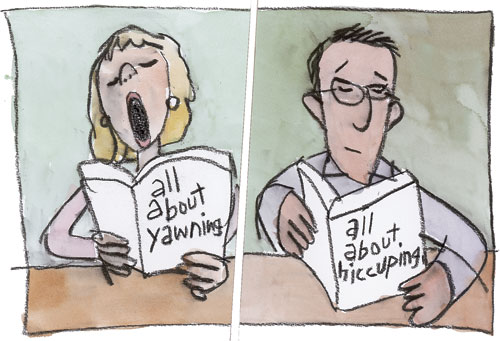
Tom Dunne
I already had experimental evidence of this inhibition when I began studying yawning contagion, providing the rationale for the use of self-report in experiments. As my yawning studies attracted attention (the popular media have a voracious appetite for stories on this topic), I had the experience of seeing the inhibition play out.
A television news-magazine crew turned up one day to tape a segment. Against my advice, the show's producer set out to recreate my experiment in which one-half of a large lecture class read an article about yawning while the other half read a control passage about hiccuping. Normally the effect of the yawning article is robust, and it has been used as a demonstration of contagion in classes at other universities.
As I predicted, the demonstration did not survive up-close-and-personal scrutiny by a national network television crew. With the cameras rolling as the students read, only a tiny fraction of the usual amount of yawning was observed. The video crew performed an unintentional but informative variant of my original research demonstrating the powerful effect of social inhibition on yawning. Even highly motivated and prolific yawners who volunteered to be on national television stopped yawning when placed before the camera. It is notable that the social inhibition of yawning occurred unconsciously and was not the voluntary effort of the yawner to suppress a rude or inappropriate act. A socially significant act can be either produced or inhibited by unconscious processes.
Scrutiny also inhibits hiccuping, an act that is also unconscious but is not contagious. When piano students in my wife's home studio start hiccuping, she signals me to bring my tape recorder into the studio to record their sounds. In all nine cases where we have used this technique, my appearance with recorder and microphone has been followed almost immediately by an end to the hiccuping. I've thus discovered an effective treatment for the hiccups while finding further evidence for the social inhibition of an unconsciously controlled act. When the ancient and the new, the unconscious and the conscious compete for the brain's channel of expression, the more modern, conscious mechanism dominates, suppressing its older, unconscious rival.
Too little is known for this article to end with a dazzling intellectual flourish and a Grand Unified Theory of Yawning. It is customary at this point, though, to suggest a need for further study, and indeed I see much potential in using yawning to develop and test theories of mind and to better understand certain neuro- and psychopathologies.
Here I have attempted to describe the yawn, when we do it and its promise for study, without speculating about its function. Yawning appeared very early in vertebrate history, with contagiousness evolving much later. Yawning has many consequences, including opening of the eustachian tube, tearing, inflating the lungs, stretching and signaling drowsiness, but these may be incidental to its primal function—which may be something as unanticipated as sculpting the articulation of the gaping jaw during embryonic development.
Selecting a single function from the many options may be an unrealistic goal. However, reviewing the disparate facts, I'm impressed that yawning is associated with the change of behavioral state—wakefulness to sleep, sleep to wakefulness, alertness to boredom, threshold of attack, sexual arousal, switching from one kind of activity to another. Yawning is a vigorous, widespread act that may stir up our physiology and facilitate these transitions, with the motor act becoming the stimulus for the more recently evolved contagious response.
Consider the Bakairi people of central Brazil as observed by their first European visitor, 19th-century ethnologist Karl von den Steinen. Irenäus Eibl-Eibesfeldt recalls in his 1975 book Ethology that Steinen reported: "If they seemed to have had enough of all the talk, they began to yawn unabashedly and without placing their hands before their mouths. That the pleasant reflex was contagious could not be denied. One after the other got up and left until I remained with my dujour." Among all members of our species, the chain reaction of contagious yawning synchronizes the behavioral as well as the physiological state of our tribe. Yawning is a reminder that ancient and unconscious behavior lurks beneath the veneer of culture, rationality and language, continuing to influence our lives.
Click "American Scientist" to access home page
American Scientist Comments and Discussion
To discuss our articles or comment on them, please share them and tag American Scientist on social media platforms. Here are links to our profiles on Twitter, Facebook, and LinkedIn.
If we re-share your post, we will moderate comments/discussion following our comments policy.